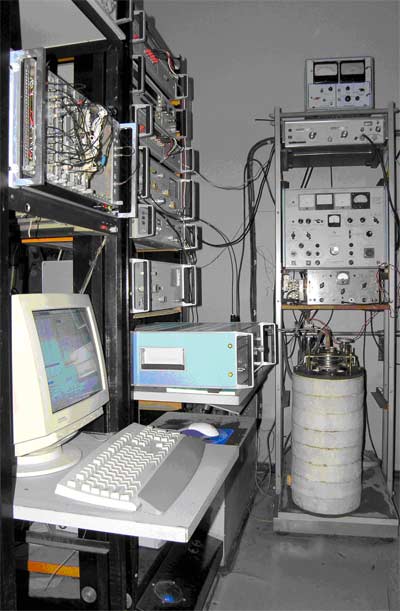Pulsed Magnetic Resonance Spectrometer
Developed at the Kirensky Institute of Physics, Russian Academy of Sciences, Siberian Branch
Magnetic resonance is one of the most informative techniques for studying the magnetic properties of materials. The electron magnetic resonance can be observed in both disordered and ordered magnets. The analysis of magnetic field-frequency dependences of the magnetic resonance is used in magnetic structure investigations and measurements of exchange, anisotropy, Dzyaloshinski and other effective fields.
Researchers of the Laboratory of Resonance Properties of Magnetically Ordered Media, Kirensky Institute of Physics, developed the magnetic resonance spectrometer operating in wide frequency and magnetic field ranges. The pulsed technique allows broadening the magnetic field range due to the multimode waveguide and a set of replaceable generators and traveling wave tubes used.
Specification
- working frequency 25−140 GHz;
- pulsed magnetic fields up to 100 kOe;
- pulse length τ = 12.63 ms;
- field nonuniformity at the coil center of no worse than 5•10-4 per 1 mm3;
- temperature range 4.2−400 K;
- capacitor bank capacitance (MBGV 200/1000) 18.9 mF;
- maximum charge voltage 1000 V.
|
|
Schematic of the automated pulsed magnetic resonance spectrometer. (1) millimeter- and centimeter-range microwave generator, (2) isolator, (3) attenuator, (4) directional coupler, (5) detector section, (6) solenoid, (7) sample, (8) broadband amplifier, (9) pulsed magnet power supply, (10) capacitor bank, (11) noninductive resistance, (12) digital voltmeter for measuring the thermocouple signal, (13) digital voltmeter for measuring the charge voltage, (14) capacitor bank charging/discharging control card, (15) interface card, (16) computer. |

|
The spectrometer allows observing the magnetic resonance in various magnets, including those with a large initial spectral splitting. The objects of study can be both magnetically ordered substances (ferromagnets, ferrimagnets, antiferromagnets, and amorphous magnets) and paramagnets and spin glasses. The spectrometer is automated in the CАМАC standard [1] with the use of standard modules, including high-speed 10-bit analog-to-digital converters, and original support circuits. The Windows operating systems software serves for controlling charging/discharging processes and temperature and automated recording of a spectrum in a file. Since the spectrum recording time is short (12 ms), a specific algorithm for starting the analog-to-digital converters and field scanning was developed. The magnetic resonance spectrometer was used in investigations of pure and doped α-Fe2O3, Bi2CuO4, LiCu2O2, CuGeO3, Cu5Bi2B4O14, and CuB2O4 compounds, huntite crystals RFe3(BO3)4 (R is the rare-earth ion), manganite crystals RxA1-xMnO3 (R = La, Eu, or Nd and A = Pb or Na), etc. 1. V. I. Tugarinov, I. Ya. Makievskii, and A. I. Pankrats, An automated magnetic resonance spectrometer with a pulsed magnetic field // Instruments and Experimental Techniques, 2004, no. 4, pp. 56—61. |

